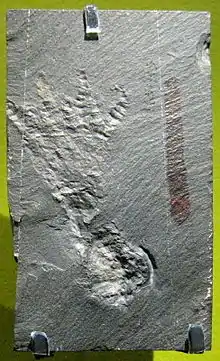Echmatocrinus
Echmatocrinus is a Cambrian animal which resembles a crinoid or an octocoral. Its exact taxonomy is still a subject of debate. It is known only from the Burgess shale.[1] 5 specimens of Echmatocrinus are known from the Greater Phyllopod bed, where they comprise < 0.1% of the community.[2]
| Echmatocrinus | |
|---|---|
 | |
| Echmatocrinus brachiatus | |
| Scientific classification | |
| Kingdom: | Animalia |
| Phylum: | incertae sedis |
| Genus: | †Echmatocrinus |
| Species: | †E. brachiatus |
| Binomial name | |
| †Echmatocrinus brachiatus Sprinkle 1973 | |
The creature was a little like an inverted cone, with a crown of seven to nine tentacles.[1] Each tentacle was covered with small extensions. The cone itself was covered with irregularly arranged mineralised plates.[1] The organisms lived a solitary lifestyle, although juveniles are sometimes attached to (or budding from) adults.[1]
References
- Babcock, L. E.; Ausich, W. I. (2000). "Echmatocrinus, a Burgess Shale animal reconsidered". Lethaia. 33 (2): 92–95. doi:10.1080/00241160050150221.
- Caron, Jean-Bernard; Jackson, Donald A. (October 2006). "Taphonomy of the Greater Phyllopod Bed community, Burgess Shale". PALAIOS. 21 (5): 451–65. doi:10.2110/palo.2003.P05-070R. JSTOR 20173022.
External links
- "Echmatocrinus brachiatus". Burgess Shale Fossil Gallery. Virtual Museum of Canada. 2011.
Further reading
Ausich, W. I. 1998a. Early phylogeny and subclass division of the Crinoidea (phylum Echinodermata). Journal of Paleontology 72 (3): 499-510.
Ausich, W. I. 1998b. Origin of the Crinoidea. In Echinoderms: San Francisco (R. Mooi & M. Telford, eds.) pp. 127–132. A. A. Balkema: Rotterdam.
Ausich, W. I. 1999. Origin of crinoids. In Echinoderm Research 1998 (M. D. Candia Carnevali & F. Bonasoro, eds.) pp. 237–242. A. A. Balkema: Rotterdam.
Sprinkle, J., & R. C. Moore. 1978. Echmatocrinea. In Treatise on Invertebrate Paleontology pt. T. Echinodermata 2. Crinoidea (R. C. Moore & C. Teichert, eds.) vol. 2, pp. T405-T407. The Geological Society of America, Inc.: Boulder (Colorado), and The University of Kansas: Lawrence (Kansas).